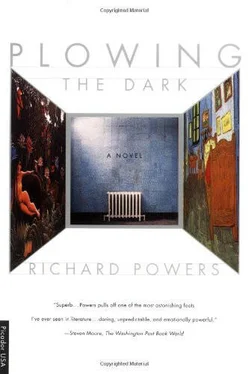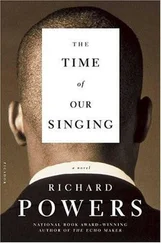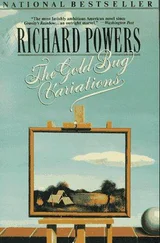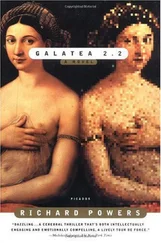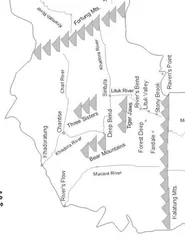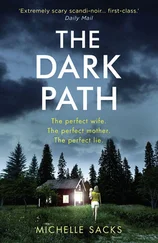All this Adie Klarpol saw in a single, smooth glance. The men she worked with meant to assemble all these things, and then some.
Aries gleamed. The Mediterranean morning shone from out of the electronic scrap heap of the lab surrounding it. She watched the programmers test the latest audio algorithms. Video edge-detection routines tracked all movement in the room, punctuating any action that might generate sound. Jackdaw Acquerelli slipped off his shoes. He nudged them with a toe, under the lip of the bed. They scraped across the floor of the Cavern, a noise half actual, half synthetic. The elaborate basketball shoes sat like two hollowed-out white lab rabbits, visible through the illusion of the bed, but still beneath it.
Pretty soon, Jackdaw said, any year now, this room will be good enough to live in.
That, finally, was the hope. To live in the room that the painter's suicide vacated. The soul simply wanted better accommodations. Something more spacious to fasten to. Something more like itself than that dying animal.
It had taken Adie a year and a half to see what she was working on. The rest of the lay world made the same leap in the space of a single Memorial Day weekend. Overnight, an explosion of interest rocked the RL, as if the mountainside they hugged chose that moment to simulate St. Helens. Media latched wholesale upon this thing that it refused to call anything else but virtual reality. The public took so quickly to the fantasy that it must have recognized the contour from something it already knew.
The press launched a full-frontal assault. Journalists closed in on virtual reality as if on a celebrity murder. The luxury of monastic tinkering dissolved under the onslaught. Freese found himself devoting half his time to fielding reporters' questions. Disruption reigned supreme. The RL's mountain hideaway began to appear in speculative magazine accounts and TV news spots, reports that turned the lab's jerky, wire-framepredictions into gleaming, ray-traced chrome.
No one could say why, after thirty years of research in obscure labs across the Northern Hemisphere, VR overnight became 1990's cover girl. A couple of research outfits let the ghost out of the machine before it was time. Here and there, universities began to demo projects that suddenly had the whole world talking as if full-body dives into wraparound LSD, robotic prostitution, and long-distance teledildonics would hit the toy store shelves by Christmas. Two or three start-up firms, eager to appease their serial venture capitalists, began to sell cheap telegloves, stripped-down head-mounted displays, and even body suits whose performance amounted to little more than faint holograms of their hinted potential.
In the Santa Barbara Sheraton, at March's research conference for virtual environment and telerobotics interfaces, Freese stood at the back of a packed grand ballroom. Just looking out on the sea of charged participants rearranged his viscera. His cobbled-up cottage craft had graduated beyond an esoteric discipline. Ready or not, reality engineering was about to become a full-fledged industry.
A world begging for deliverance cared nothing for a porcelain jug sitting on a rickety wooden bed stand. But the inexorable market machine that had, just the previous year, swallowed up the globe's last holdout nations already knew what it wanted from virtuality. It wanted holophonic videoconferencing. It wanted the Ferris wheel-cum— feature film. All-talking, all-singing, incarnate sex fantasies. Interplanetary mining from the comfort and safety of our own back yard. But the market craved something more significant as well. Something more fundamental.
Industry saw, in the Cavern and comparable virtual vistas, the race's next launchpad. The first commercial use of virtual space would be as a three-dimensional workbench for designing every physical trinket from saucepan to space station. In that lucid crucible, any conceivable device could be probed from all angles before incurring the expense of manufacture. Even the components for the next generation of Cavern itself could be taken for a 3-D test drive, revealing, in conceptual space, their optimal form before coming into the world. The amount of cash waiting to be thrown at the magic workbench, the sums waiting to be made could swallow the Rl, budget many times over, for generations upon generations. For the human project had many more goods to make, before its final triumph over goods.
It was here already: the Pong of Things to Come. Downtown, a dozen blocks from Pioneer Square, where Spiegel and Adie had strolled only months before, a technopalace opened up where, for ten bucks, University of Washington kids and frustrated Boeing execs could sit in networked cubicles and blast deep-animated representations of one another out of the infinite vacuum of space. And the month after that arcade opened, Hollywood released the first of several feature-length spawn — a heavily chromed rendition of the new Aladdin and his wonderful data glove. The grand future vision that the RL pioneered was rapidly being left in collective imagination's dust. Must you Americans oversell everything? Rajasundaran asked. Freese liked the aggressive ones. Oversell? You can't oversell this. We're engineering the end of human existence as we know it. Not as I know it, White Man.
Still, Freese insisted: it was the end. The end of something. An end to the limits of symbolic knowledge. Beyond the hype, past the immediate feeding frenzy, the press had gotten at least that much right. But even in the thick of the current mania, no one had yet guessed how big this thing was going to get. No one.
The Cavern threatened the final disappearance of interface. Future operators would engage simulation in the same way that humanity's current version engaged material existence: using all the degrees of freedom built into their sovereign bodies. The right way to grasp the planet's mounting sandcastles of data was to step inside and poke around.
As the scramble for funds broke out everywhere, Freese took his ideas on the lecture circuit. The computer would go transparent, more invisible than all its crude, qualified precursors in representation. Talking to data would be like talking to a friend over the phone. Explorers would move through a literal forest of numbers, strolling through their woody representations and singling out by sight or sound or smell the significant trees, the hidden arbors.
Freese's techno-evangelizing carried a strong dose of private salesmanship. No other start-up in the fledgling reality industry had yet shown anything remotely in the league of the prototype Cavern. The Cavern, Freese teased, would make head-mounted displays and cumbersome gloves seem like Smell-O-Matic, SensaVision, or any other doomed evolutionary backwater. He always ended his speeches with the coy suggestion that everyone stay alive long enough to see the thing that their imaginations couldn't quite visualize yet.
But privately, back at the mountain, he fretted. He sent off an anxious e-mail to the brass at TeraSys. The whole fad may quite simply fade before we get the real thing to market- In the current climatei potential clients for genuine immersion environments could well feel burned by their own expectations and sour on all subsequent demos-i once the bubble bursts…
As project administrator, Freese managed a delicate balancing act between come-on and kiss-off. He could say nothing of the project and risk being lost in a sea of false claims. Or he could promise the world and risk failing to satisfy. Already, knots of prospective cyber-nauts were queuing up in the RL's parking lot, cash in hand. But the Realization Lab was worlds away from showing anything that resembled a finished product. All they had was proof of concept.
Читать дальше
